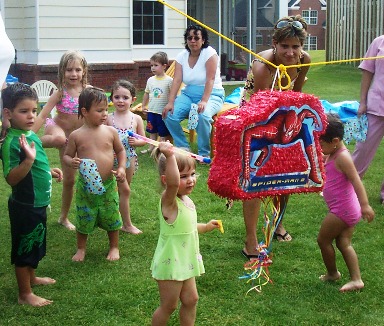
A piñata is a thin clay pot, covered in vibrant decoration. Paper mache is stuck to it, creating a host of wonderful designs in a blaze of color. Mexico markets will sell them in the shape of superheroes, flowers, animals, popular toys, celestial objects; you name it and there will probably be a piñata in that design. For Christmas, there are piñatas of reindeer, Santa Claus, stars, baubles and many other festive shapes. However, the original is that in the image above.
It was introduced into Mexico, as an Italian cultural item, by early Christian friars. The coming of the Spanish meant a lot of upheaval for native people. Wars saw the destruction of their homes and crops; while European diseases, like smallpox, had never been in the Americas before. The population here had no immunity and the resulting death-toll was even higher than in the fighting itself. This meant that a lot of people were starving.
Pope Sixtus V suggested that piñatas might lure these people into the missionaries and churches. The clay pot was filled with food, especially nuts and fruit, then hung beside the nativity scenes. The people were given sticks and the Catholic concept of sin was explained to them. The spikes of the original piñata represented the seven deadly sins. As they hit the piñatas, with their sticks, they were symbolically smashing those sins. This was done blindfolded, as a sign of faith. Their reward was the food, which cascaded down, once the clay pot inside was sufficiently broken.

However, some historians dispute the idea that it was Christian missionaries who brought the piñata to Mexico. They merely adapted a ceremony that already existed. Scholars point to the fact that the Aztec God of War, Huitzilopochtli, was honored with piñatas. The clay pots were filled with food and precious items. The outside of the pot was decorated with feathers and beads. Worshippers hit the pot with a stick to shatter it, thus allowing the God's bounty to fall at their feet. It was a reminder that fighting will gain rewards. After all, this was the God of War.
There is also some evidence that the Aztec God, honored in this way, was Tlaloc. As he was the Rain God, then the pots were filled with water. People took turns to smash it. The person ultimately drenched was the one upon whom Tlaloc had bestowed his blessing.
These days, piñatas are more likely to be filled with candy and small toys. Any child old enough to wield a stick may take their turn at whacking it. Eventually, the pot smashes and children scramble to pick up their treats. It's all great fun!



Great Post! Thanks for sharing with us.
ReplyDeleteCancun Airport Transportation
Mexico City Tours
Playa del Carmen Tours